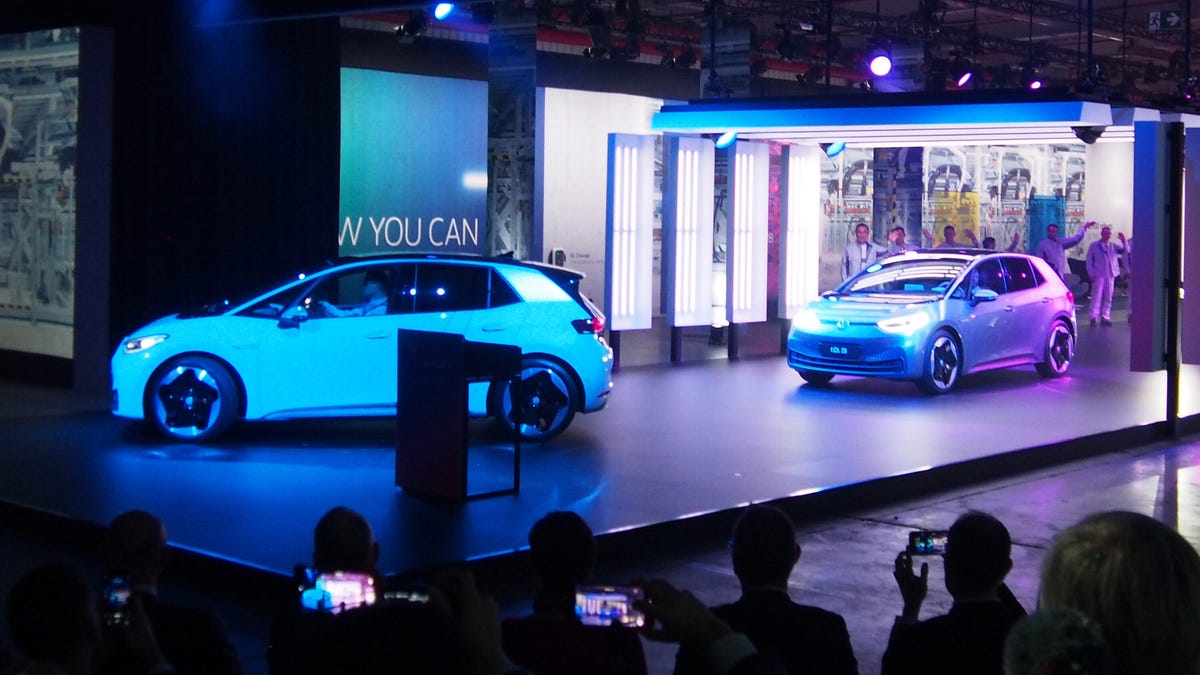Volkswagen ID 3 production has officially started in Germany
Volkswagen is working to revolutionize the automotive industry by offering a range of all-electric vehicles. The ID 3 hatchback is the first of these products to start being manufactured.
Production of the Volkswagen ID 3 all-electric hatchback kicked off at the automaker's retooled plant in Zwickau, Germany on Monday. The launch of this car, and its forthcoming derivatives, is a huge milestone for the company, one they liken to the introduction of other legendary models like the original Beetle and Golf.
"The ID 3 is a car we will bring to the volume, [to] take e-mobility out of the niche," said Thomas Ulbrich, board member for e-mobility at the Volkswagen brand. "It's really the starting point of a system change from ICE (internal-combustion engines) to BEV (battery-electric vehicles) that is, let's say, mainly the base for our commitment starting to strive for a CO2-neutral future in the automotive industry."
All in on EVs
The Volkswagen Group is making a major push into the electric-vehicle space, and ID 3 is the tip of their spear. By 2028, the industrial conglomerate is aiming to offer around 70 different battery-powered vehicles, with estimated sales hitting 22 million units.
The ID 3, which was unveiled last autumn at the Frankfurt Motor Show, is built atop a brand-new electric-vehicle architecture called Modular Electric-Drive Matrix, MEB for short. That's Modularer E-Antriebs-Baukasten if you prefer the German name.
Volkswagen's future depends on electric vehicles like the new ID.3.
This platform features a scalable battery pack that's integrated right into the vehicle's floor. Mounting it underfoot provides a low center of gravity for enhanced handling and more interior space.
Helping keep that electron reservoir topped up, in Europe, VW is also making significant infrastructure investments. Ulbrich said the company "will install, until 2025, more than 30,000 charging points in our facilities [and] in our dealerships." With the new ID 3 and the easier ability to keep them juiced up he added, "I think there's a good chance that e-mobility now will be successful."
East German roots
Enabling the ID 3's launch, Volkswagen is converting its Zwickau manufacturing facility into a dedicated electric-vehicle plant, the world's largest of its kind. Around 1.2 billion euros ($1.3 billion) and two years' worth of work has been invested in the historic facility to move this transformation forward.
Even though the ID 3 has entered production, internal combustion-powered vehicles is are still being made in Zwickau. This will change over the next couple years as the automaker completes its transformation of the plant. Once finished, it will have the capacity to build around 330,000 EVs annually, with daily production actually increasing from 1,350 units to 1,500.
Here's a body shell before the interior, drivetrain or other significant components are installed.
About 8,000 people will work to produce the new ID 3. Germany is not a country known for its affordable labor, but helping keep costs in check, and enabling VW to build these cars profitably, employees are aided by some 1,700 robots and more than 500 driverless transport systems.
Volkswagen's Zwickau factory is now thoroughly modern, quiet a transformation for an assembly plant that used to build Trabants, the infamous East German car famed for its crudeness and smoke-belching, two-stroke engine. More than 3 million of these communist machines were made between 1957 and the cessation of production in 1991. The VW Golf and Polo as well as other models have been built there over the years, too.
Beyond Zwickau, VW will build MEB vehicles at eight facilities around the world, including in Emden and Hanover, Germany, and at two plants in China. The automaker is also investing $800 million in its Chattanooga, Tennessee factory to make electric cars .
ID 3 overview
Sized roughly like a Golf, the ID 3 has a much longer wheelbase thanks to reduced overhangs. This gives it more interior space, room comparable to a midsize car.
Rising from the particulate ashes of the diesel-emissions scandal a few years back, the ID 3 is designed to be manufactured in a climate-neutral manner using efficient methods and clean energy. Unavoidable carbon emissions will be offset by other means, like supporting the Katingan Mataya Forest Protection project on the Indonesian island of Borneo. Other carbon dioxide-offsetting projects will also be implemented in Europe and India as well, but details have not been released about these projects at this time.
The ID.3 is a handsome, five-door hatchback.
The ID 3 will be offered with three different battery sizes. The smallest one has 45 kilowatt hours of capacity and should deliver a driving range of about 205 miles. The biggest pack is rated at 77 kWh and should be able to cover up to 342 miles between recharges. Splitting the difference, a 58-kWh, 261-mile battery is also available. Tapping into a 100-kW fast charger, all variants can be juiced up to about 180 miles of range in just 30 minutes.
The ID 3 is estimated to start at less than 30,000 euros before any subsidies. It's slated to go on sale in Europe roughly next summer.
Coming to America… just not soon
This all-electric model is not slated to be offered in America, given our general dislike of hatchbacks , but a battery-powered, MEB-based SUV will be offered on this side of the Atlantic. Whether it's called the ID 4, ID Crozz or something else entirely remains to be seen.
This upcoming model will likely be unveiled at the Chicago Auto Show early next year. It's expected to go on sale roughly by the end of 2020, imported from Europe at first, but ultimately produced locally in Chattanooga once it's retooled to start manufacturing electric vehicles.


